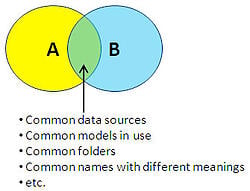 by Rick Ryan - Envisn, Inc.
by Rick Ryan - Envisn, Inc.
Managers or administrators are often faced with the task of consolidating or merging Cognos BI environments. This may result because of mergers, cost savings or simply a desire to have fewer environments to manage. Invariably the consolidation involves users and content that will be merged into a new or existing environment and this requires careful planning and flawless execution in order to be done successfully. The purpose of this article is to help you identify what you need to know and how to plan and execute a successful merger of Cognos environments.
Scoping out the merger
A project like this is a big deal and not to be taken lightly. A merger usually involves merging one existing environment into another one. But it could also involve merging two or more environments into a new one. An example would be merging two Cognos 8 environments into a new Cognos 10 one.
The first thing you need to do is to scope out the environments to be merged. This requires a lot of detailed analyses in order to get the data needed to prepare a plan. Some of the things you will need to know include:
- Are the environments more similar or dissimilar?
- The number of users and the amount of content.
- Do any of the same users exist in both environments?
- Does any of the same content exist in both environments?
- How will the security model differ (if at all) between source and target?
- Can you identify and eliminate any unused content?
- Special issues – dependent on the specific needs of the environments
If this involves more than two environments that are being merged you will need to get the same information for the others as well. In many respects the task will be significantly easier if there is no overlap between users and content between the environments to be merged. Why? See the diagrams below:

Separate and distinct Environments: Where the source and target environments are dissimilar and have no overlap there are fewer things you have to deal with. However, where the source and target environments similar it is likely that there are more things you will need to address before merging the two environments:

Similar or Overlapping Environments: In the above diagram both source and target are similar raising the possibility for multiple issues on common data sources, folders, models, etc. Identifying and resolving these issues can be tedious and time consuming but absolutely necessary for a successful merger.
Creating the plan
Once you have collected the information you will need to identify and layout the key tasks to be done and get them in the right sequence. Most problems in a project like this occur when key steps are missed or placed in the wrong order. The planning should include:
- Collect the needed detail information
- Decide how common issues will be dealt with
- Decide how to deal with unused content
- Modify, if necessary, the security model in the target environment
- Map the tasks to the timeline
- Review the plan with key constituencies
- Test and validate
- Communicate the plan to the users
- Execute the plan
If you want to avoid the “big bang” approach of a deployment and do the merger in a more controlled manner you can use a product like NetVisn which allows you to simply move the content from the source to the target at a measured pace. And if you have to move hundreds, or even thousands of users, this can be a huge risk reducer. It also has the advantage of validating all objects as they are being moved to insure that all dependent objects are moved together and that they actually work in the new environment. Using a deployment package is an “all or nothing” approach that can instill fear in even the most careful planners. But for many this may be the only alternative.
Summary
Merging or consolidating Cognos environments can be a challenge even if they are small of mid-sized. In a large environment the difficulties are magnified. Creating a plan that reflects the specific needs of the environments to be merged is essential for success. Using tools that make the task easier and minimize risk can help insure success and reduce the time and effort involved.
© 2011 - Envisn, Inc. – All rights reserved
Image by: RaGardner4





